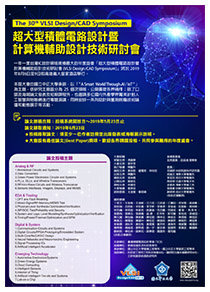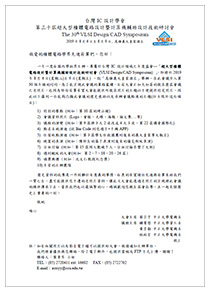Oral 4: SoC Design in Emerging System
Session Chair: Yu-Hsuan Lee (Yuan Ze University) and Ching-Hwa Cheng (Feng Chia University)Date: Aug. 7 (Wed.), 2019
Time: 13:30 – 15:00
Room: 7F 論語廳+大學廳
| 順序 | 口頭報告論文 |
| 1 | 13:30 – 13:43 (S0094) 20 M bit/s Visible Light Communication Based on 16QAM OFDM Transmission by Using Red LED Zhen-Hao Zhu (1), Wei-Ting Lin (1), Yu-Jung Wang (1), Siou-Lin You (1), Cheng-You Ho (2), Chi-Lun Hsu (2), Chun-Hsing Lee (2), and Hsi-Pin Ma (1) (1) National Tsing Hua University and (2) Industrial Technology Research Institute Abstract: In this paper, we present a 20 Mbit/s visible light communication (VLC) system based on red light emitting diode (LED). For VLC systems, intensity modulation with direct detection (IM / DD) is widely used, which means that the transmitted signal must be non-negative and real-valued. In this system, we implemented the DC-biased optical orthogonal frequency division multiplexing (DCO-OFDM) architecture and solved the synchronization problem in OFDM systems. In addition, the least square (LS) algorithm is used to estimate channel response. Bit error rates (BER) is under 0.00048 after 15 cm free space transmission. |
| 2 | 13:43 – 13:56 (S0078) A Design Platform for Smart Sensor Development Chun-Ming Huang, Chih-Chyau Yang, Yi-Jie Hsieh, Chun-Wen Cheng, Yu-Tsang Chang, and Chien-Ming Wu Taiwan Semiconductor Research Institute, National Applied Research Laboratories Abstract: Due to the fast advance of IC fabrication and electronic design automation technologies, integrating a smart sensor design into a single chip has become practical. To assist the MEMS sensor teams in Taiwan academia to accelerate their smart sensor development, this paper presents a design platform for smart sensor development which consists of a common platform unit and a sensor unit. Our proposed design platform provides the solutions of FPGA, Smart Sensor on Chip (SSoC), and Smart Sensor in Package (SSiP) for smart sensor implementation. The deliverables and design flows for the FPGA-based, SSoC and SSiP smart sensor implementations are also presented in this paper. The proposed smart sensor common platform unit was taped out with UMC 0.18um process to perform the silicon proof. The experiment results show that the presented smart sensor platform is very suitable for smart sensor development. |
| 3 | 13:56 – 14:09 (S0097) An Efficient VLSI Architecture Design for Real-time Image Object Tracking Applied to UAV Yao-Fong Huang (2), Yu-Syuan Jhang (2), Ming-Hwa Sheu (2), Shin-Chi Lai (1), and Chi-Chia Sun (3) (1) Nanhua University, (2) National Yunlin University of Science and Technology, and (3) National Formosa University Abstract: This paper presents an object tracking algorithm based on sample grouping in terms of hue, saturation, and value (HSV), and has been applied to unmanned aerial vehicle (UAV). The background group is determined by the information which is around the selected target object so that the target object can be effectively extracted from the background. By using the group information to divide the background and object, the HSV sample grouping can be elicited and grouped from the object area, and then the candidate of group samples is obtained. Here, we proposed a Gaussian mixture sample distribution (GMSD) method to enhance the performance. The candidates of object after grouping are used for searching the best matching region coordinate, where the matching criteria is based on the minimum difference between the group central value and the standard deviation. The experimental results show that the proposed method can real-time processes the full HD video, and the tracking performance of this work is better than that of previous works. Additionally, the proposed method can handle the illumination variation, object scaling variation, object fast motion, object shading, and object out of view. |
| 4 | 14:09 – 14:22 (S0140) A Novel 3-D Oximeter Image System for Breast Cancer Diagnostics Wen-Jun Wu, Jia-Jiun Guo and Wai-Chi Fang National Chiao Tung University Abstract: Diffuse optical tomography (DOT) is a relatively novel, noninvasive and nonionizing technique for breast tumor diagnosis. This study proposed 3-D Oximeter Image System as a novel approach for early detection of breast cancer. The proposed system reconstructed oxygen saturation (SpO2) distribution map of breast tissue with two wavelengths of 735nm and 890nm in real-time. The measuring method uses the diffused image of breast sample to create a three-dimensional distribution map of the entire measured region. The functionalities of a validation use an experimental human breast phantom. The proposed system can effectively detect tumors at a depth of 20mm. This system correctly identified tumors for a sensitivity of 87.5 % and specificity of 93.7 % within the breast tissue. |
| 5 | 14:22 – 14:35 (S0045) Hierarchy Quadruple-Voltage Low-Power Chip Design Methodology Ching-Hwa Cheng Feng Chia University Abstract: A Hierarchy Multiple-Voltage EDA framework, HMulti-Vdd is proposed to effectively reduce power consumption. The proposed HMulti-Vdd can be utilized to identify how many voltage-domains are better to design a performance-power optimized multiple-Vdd chip. The power consumption can be effectively reduced up to 50%, and the performance loss can be kept to within 5% of this chip. HMulti-Vdd EDA framework can help designers to reduce the manual efforts to design the multiple-Vdd chip. This automation design framework identifies a separation of high-voltage and low-voltage module in front-end and back-end chip synthesis stages. HMulti-Vdd includes performance, area, and power design guidance, while joint with several commercial circuit-synthesis and physical place-route EDA tools when designing the chip. By applying HMulti-Vdd, the multiple-Vdd chip design can be quickly redesigned based on the power, delay-time and gate-count optimization requirements. |
| 6 | 14:35 – 14:48 (S0080) A CHF Detection System with 1D CNN Bei-Lin Chuang (1), Yan-Hong Lin (2), Chi-Sheng Hung (2), and Hsi-Pin Ma (1) (1) National Tsing Hua University and (2) National Taiwan University Hospital and National Taiwan University Abstract: Recently, with the significant increase in the number of cardiovascular diseases, automatic classification study of ECG signals (ECG) has always played a very important part in clinical diagnosis of cardiovascular diseases.In this paper, a 1D convolution neural network (CNN) based method is proposed to classify ECG signals. The proposed detection system could be composed of three portions: data pre-processing, model-establishment and classification.Afterwards, through the neural network structure to train the model and get the classification result. The recognition accuracy between CHF and Control is up to 97.57% for training set, and 95.31% for testing set,significantly outperforming several typical ECG classification methods. |
| 7 | 14:48 – 15:01 (S0171) DI-SSD: Desymmetrized Interconnection Architecture and Dynamic Timing Calibration for Solid-State Drives Ruei-Fong Chiu, Jian-Hao Huang, and Ren-Shuo Liu National Tsing Hua University Abstract: NAND flash-based solid-state drives (SSDs) have long been architected in the way that the interconnections between a flash controller and the associated flash memory chips operate at a symmetric speed in both directions. However, this commonly accepted and widely used architecture is suboptimal to SSDs because reading flash cells is 10 to 20× faster than writing them. In response, we propose desymmetrized interconnection SSD architecture (DI-SSD) and dynamic timing calibration (DTC), which selectively push the flash-to-controller speed to the limit. We conduct comprehensive experiments including characterizing real SSD products, using industrial-strength IC test equipment to emulate a flash controller that adopts DTC, and simulating DI-SSD using simulators to demonstrate the benefits of our proposals. |
指導單位:
教育部資訊及科技教育司
主辦單位:
臺灣積體電路設計學會
承辦單位:
國立中正大學電機工程學系
國立中正大學資訊工程學系
協辦單位:
科技部工程司工程科技推展中心
國研院台灣半導體研究中心
中國電機工程學會
智慧聯網整合推動聯盟中心
中央研究院資訊科學研究所
贊助單位:
聯發科技股份有限公司
日月光半導體製造股份有限公司
威鋒電子股份有限公司
奇景光電股份有限公司
荷蘭商益華國際電腦科技(股)公司台灣分公司
台灣新思科技股份有限公司
財團法人工業技術研究院
瑞昱半導體股份有限公司
聯詠科技股份有限公司
鈦思科技股份有限公司
台灣是德科技股份有限公司
和澄科技股份有限公司
愛爾蘭商明導股份有限公司台灣分公司
一元素科技股份有限公司
力旺電子股份有限公司
博鑫醫電股份有限公司
群聯電子股份有限公司
晶心科技股份有限公司




